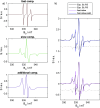R5 Peptides Constitute Condensed Phases with Liquid-Like Properties in Biomimetic Silica Capsules
- PMID: 40267258
- PMCID: PMC12051205
- DOI: 10.1021/acs.jpclett.5c00144
R5 Peptides Constitute Condensed Phases with Liquid-Like Properties in Biomimetic Silica Capsules
Abstract
Biomimetic silica-peptide nanocomposites are promising materials for applications in drug delivery and enzyme encapsulation due to their biocompatibility, tunable morphologies, and unique structural characteristics. However, the structural dynamics of the peptide scaffold remain largely elusive, impeding rational biomimetic materials design. This shortcoming is not the least due to a lack of methods that can access such heterogeneous systems with dynamics on a wide range of time scales. Among the most studied candidates are silica particles templated by the diatom-derived peptide R5, known for its ability to guide silica precipitation under mild, toxicologically friendly conditions, leading to silica capsules filled with a peptide scaffold. Here, we describe the structural dynamics of R5 within its self-assemblies and the silica particles it templates with a combination of advanced magnetic resonance methods, including 13C-direct detected NMR, site-directive spin-labeling EPR, and sensitivity-enhanced solid-state NMR. We provide evidence that R5 self-assemblies form condensed phases with liquid-like dynamics both before and after silica encapsulation. Our suite of methods allowed us to access R5/silica composites over a comprehensive range of time scales. These results demonstrate that R5 retains a remarkable degree of internal dynamics, with distinct regions of solid-like and liquid-like behavior even within the silica particles. Specifically, the peptide scaffold comprises three dynamic species: (i) solid-like at the peptide-silica interface, (ii) liquid-like mobility within the scaffold core, and (iii) intermediate dynamics at the boundary regions between core and interface species. Our findings rationalize the high mobility of guest molecules, such as drugs or enzyme substrates, within R5-silica nanoparticles, which is crucial for their functionality in controlled release and catalytic applications. This understanding paves the way for improved rational design considerations for advanced nanomaterials and expands our knowledge of biomimetic mineralization mechanisms. At the same time, the methodological approach can be useful for many types of peptide-guided biominerals, bridging fundamental biochemistry with biotechnological innovation.
Conflict of interest statement
The authors declare no competing financial interest.
Figures





References
-
- Nguyen T. L.; Cha B. G.; Choi Y.; Im J.; Kim J. Injectable dual-scale mesoporous silica cancer vaccine enabling efficient delivery of antigen/adjuvant-loaded nanoparticles to dendritic cells recruited in local macroporous scaffold. Biomaterials 2020, 239, 11985910.1016/j.biomaterials.2020.119859. - DOI - PubMed
-
- von Baeckmann C.; Riva A.; Guggenberger P.; Kählig H.; Han S. W.; Inan D.; Del Favero G.; Berry D.; Kleitz F. Targeting gut bacteria using inulin-conjugated mesoporous silica nanoparticles. Adv. Mater. Interfaces 2022, 9, 210255810.1002/admi.202102558. - DOI
MeSH terms
Substances
LinkOut - more resources
Full Text Sources

